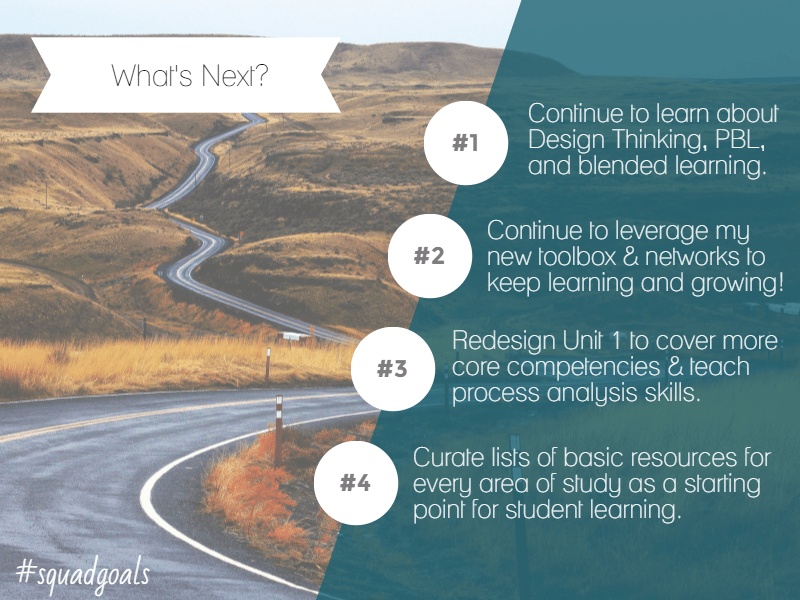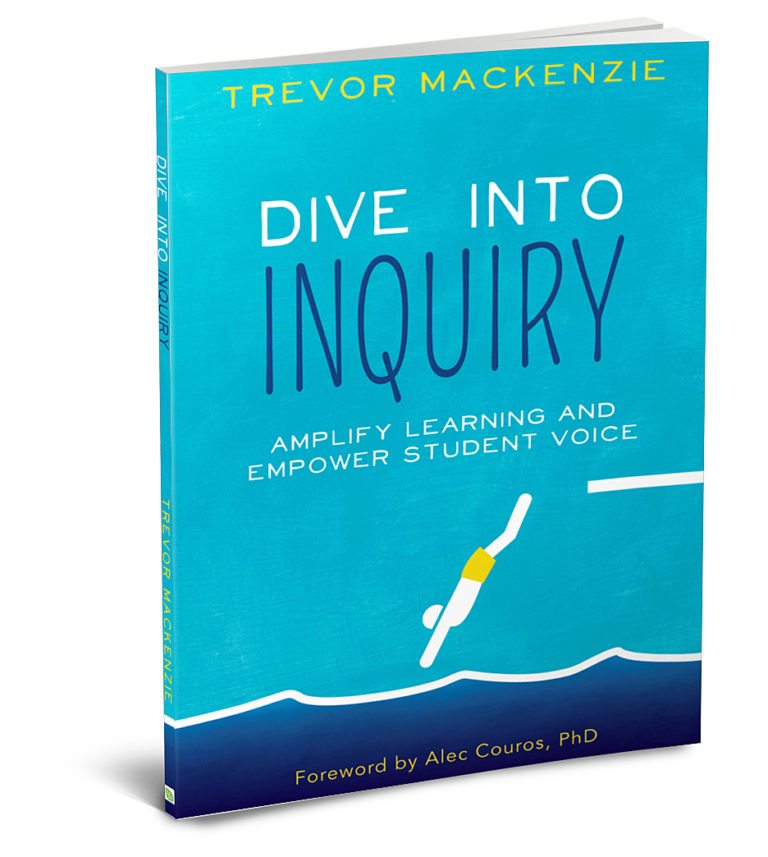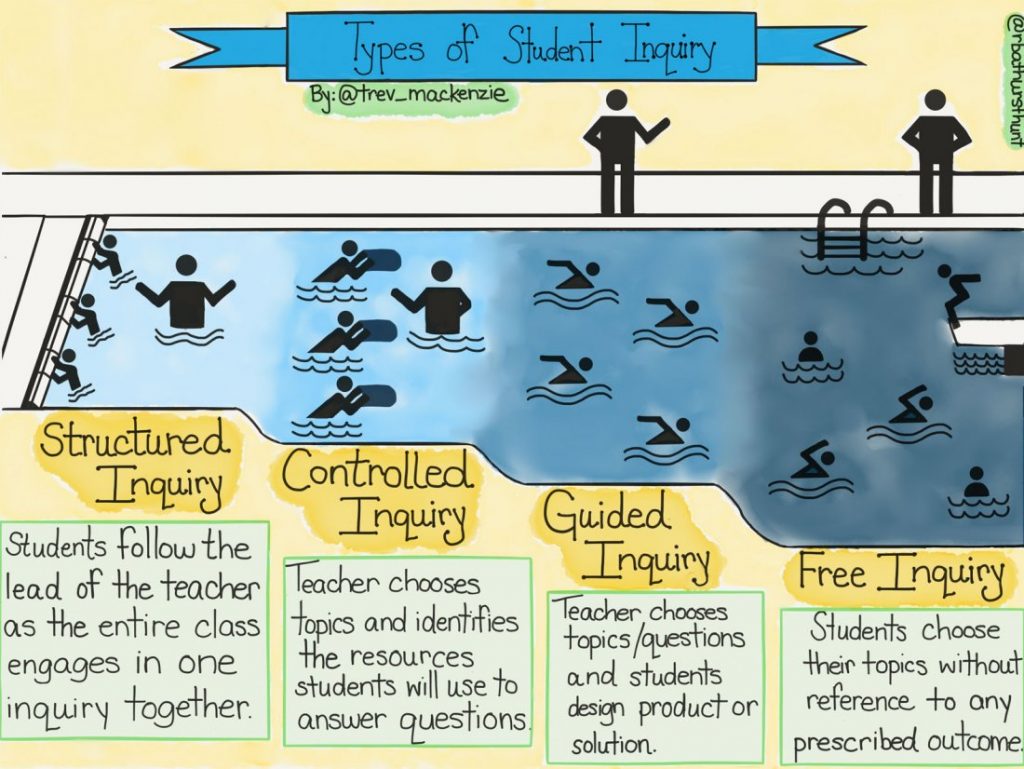As I promised last week, today I’m back with an update on my 2015-2016 Action Plan, which centred around the question “How might we restructure Communications Technology to provide more and better opportunities for personalization and project-based learning?” Although it was technically last year’s Action Plan, it was a large project of which I merely scratched the surface last year. The intention was to continue to revamping process this year, and I have made some gains in that regard.
In my final slide deck from last year, I noted four areas of focus on the “what’s next?” slide:

In some of these areas, I believe I made significant progress.
1 ) Continue to learn about Design Thinking, project-based learning, and blended learning.

I read an excellent book, Blended, over the summer, which helped to clarify some of the language around blended learning, the various models that exist, and the importance of understanding the purpose of implementing blended learning in your situation. (Is it a sustaining innovation or a disruptive innovation??) You can also read my “review” (mostly just my favourite quotes) on my Goodreads profile here. This book will continue to serve me well as I embark on my new position next year, which has as one of its mandates to develop a blended learning framework for my school.

At the EdTechTeam summit in BC in November, I was lucky enough to meet Trevor Mackenzie, author of the book Dive Into Inquiry, who gave me a copy to read. I devoured it on the plane ride home, thrilled with the possibilities that it explored about getting students to focus on their passions as a vehicle for learning. This served as a guide for me as I restructured the last four months of my course, and although I didn’t follow his formula exactly, the book provided me with some language and some structure to guide my revamping.
2) Continue to leverage my new toolbox and networks to keep learning and growing.
I continued to read blogs, both of the Cohort 21 variety and those of the wider educational community. I made regular use of Twitter to keep learning, which proved to be one of the best sources of professional reading I could have ever imagined. And I had the opportunity to present at two EdTechTeam conferences in BC, which allowed me to expand my PLN even further. Acting as a coach with Cohort 21 this year also kept me in touch with the culture of continued reflection and growth, even if I was not always completely motivated to keep up at all times. (See last week’s blog post: “On Failure” for more details about that.)
3) Redesign Unit 1 to cover more core competencies and teach process analysis skills.
This was something that I had intended to plan in more detail over the summer holidays, but it did not exactly work out that way. Summer has a way of sneaking right by us, doesn’t it? However, despite not having done a ton of advanced planning, I did manage to rework my first two units in order to cover a broader range of skills and tools.
Last year, when I taught the course for the first time, I divided it into subject-specific units: Intro to Comm Tech, Photography, Graphic Design, Videography, Audio Production, and Social Media and Marketing. The challenge, of course, is that each of these is such a vast topic that we could only cover in brief if we were to have any hope of getting through them all in a survey-type course. Students who were really interested in videography had only a month and a half to explore that area, and we could barely scratch the surface of it. This time around, I changed the focus.
Unit 1, “Fundamentals of Communications Technology,” explored the principles behind Comm Tech (what is it, anyway??), and we focused on developing fundamental skills such as care and use of equipment, file management techniques, copyright adherence, and project organization and management. We learned how to manage bookmarks and sync our Chrome browsers to become more efficient, and we explored how to use our digital SLR cameras for the most basic of photography and videography tasks. All of these skills would be fundamental going forward, regardless of what area students were interested in pursuing.
In one of my prouder moments as a teacher, I eliminated the traditional test from the course and tried for the first time a performance-based or practical test – students were simply to demonstrate for me their mastery of simple processes, and they were assessed as having “achieved mastery”, “approaching mastery”, or “not yet there”. Not surprisingly, this was much more time consuming — it took two 80 minute periods to assess the group of 19 students — but to me seemed a much fairer and more authentic way of assessing the level of students’ skills. Can they do it or not?
In Unit 2, “Adobe Creative Cloud and Design Fundamentals,” we explored basic design fundamentals such as photo composition and the principles of good design. We were introduced to a variety of Creative Cloud applications (e.g. Photoshop, InDesign, Bridge, etc.) so that students could become familiar with the interfaces and basic tools that come up in each one. Again, these skills were intended to form a baseline so that students would then be able to build upon them as they embarked on their in depth, independent studies in the areas of their choosing.
4) Curate lists of basic resources for every area of study as a starting point for student learning.
This goal shifted significantly based on the inspiration from Trevor Mackenzie’s book.
Finally, in March we began the independent units, which, based in part on Trevor’s suggested structure, I divided into two modules: Guided Inquiry and Free Inquiry.

In the Guided Inquiry module, students chose a piece of software from Creative Cloud’s suite of apps. They could choose from Photoshop, InDesign, Illustrator, Premiere Pro, Animate, Audition, and Muse. I curated resources for each of the software programs, and over the course of about a month, students worked through the resources (mostly from the incredible range of tutorials from Adobe’s website), taking notes and completing assessments and practice activities along the way. This was based on my initial forays into personalized learning last year, which focused on just Adobe Muse and Adobe Illustrator as options for students. You can read about that here.
Throughout this Guided Inquiry process, I was in the unique position of providing support and assistance while students worked through the resources, rather than standing at the front of the class providing the actual instruction. I freely admitted to students that I was unfamiliar with some of the software, and would do my best to help troubleshoot wherever possible. But the focus was on working through challenges, and seeking help from peers who were working on the same software, rather than coming to me immediately whenever they encountered a roadblock. This was a huge step in the right direction. I was able to monitor student progress and provide feedback on the learning process, as well as provide targeted support where needed. Awesome!
Now in Progress: the Free Inquiry stage
Finally, upon completion of the Guided Inquiry, we embarked on the Free Inquiry module. This would be the chance for students to really dive deeply into their area of focus. The students’ choices for the Guided Inquiry provided the basis for their topics for the Free Inquiry. For example, if a student was interested in videography as an area of focus, then they had chosen to complete the Guided Inquiry module on Premiere Pro (video editing software).
(Here I switch to the present tense, as we’re currently right in the middle of it.)
For the Free Inquiry, there are two components:
- A report, in the format of their choice, which is intended to provide a medium for students to communicate the evidence of their learning for the module. Students are required to conduct additional research, explore more tutorials, and deepen their understanding of the basic principles studied in the first two units so that they can create the most effective authentic piece possible. (See component #2.)
- An authentic piece, by which students will demonstrate their mastery of their new skills by creating a product — whether it be a marketing plan, a website, a documentary, a YouTube channel, an ad campaign, an animation, or anything else they choose! One requirement of the authentic piece is that it have an authentic audience outside of the teacher or the class. Students needed to think deeply about how they can create something that has a connection to the outside world, and I have been so impressed by the projects that some of them are choosing to undertake. One student is developing a marketing plan and website for the clothing company that he’s just started with a friend. Another is creating a promotional video for her mother’s jewellery company. Another is planning a complete design, including signage, menus, and staff uniforms, of a restaurant her father is starting. Still others are creating a shop on Redbubble where they will produce products like t-shirts and phone cases out of their original photos.
This process has been incredible for me to be a part of. Although I certainly learned several things along the way about the need to be clearer in my expectations and instructions, I have been blown away by the quality of ideas that students are proposing for their authentic piece, and the planning that they are doing to make their ideas come to life. Each class, I meet with individual students for nearly the entire 80 minutes, asking questions, getting updates on their progress, and providing feedback, ideas, resources for them to check out. Even more so now than during the Guided Inquiry, I feel like I am bringing so much more value to students in this role as coach or facilitator than I ever could as a teacher instructing the whole group from the front of the class.
Conclusion
In all, I would consider this process a success. I do not want to be content with how this has gone and leave it at that – I know that I can do better. However, I do feel as though the progress I’ve made will make it easier for another teacher to take on the teaching of Comm Tech in my absence next year without having to worry about lacking some of the technical skills that are the focus of the course.
I still have some lingering How Might We questions that I can make a focus going forward. How might I be clearer in my expectations? How might I present exemplars or provide ideas without limiting students’ creativity? How might I best help those students who lack motivation, struggle with time management, or seem not to have a passion that they want to tap into for their project? And how on earth will I assess all of these projects that are so vastly different from one another??
I would love to hear any ideas that you might have about how to continue to improve this process and make it as valuable as possible for all involved.
Hey Jenn,
I was reading your blog and saw that learning about PBL was on your radar.
HDCH hosts a teacher’s academy every summer for teachers across the province and other parts of Canada. It is a week long academy where you learn about PBL by designing a project for a class. Everyone leaves with a Project protocoled and ready to be implemented. You work in small teams with coaches throughout the week. It’s a pretty transformative week of PD. We have different levels for those along the continuum of pbl mastery. The framework is based on the Buck Institute’s model of PBl.
As a school pbl is our pedagogy of choice and we are on the journey of finding ways to use it more and more.
Does CDS use it? We are always on the look out to connect with other schools using it. We find traditional structures can make it hard to implement good pbl so are working towards innovating the way we think about what school should be and look like.
Anyway, I’m super rambling here. It would be great to have you come to the academy if you are interested in PD on PBL!
http://www.teacheracademy.ca/
Christy Bloemendal
Thank you so much for your comment, Christy! I love the sound of the teacher’s academy and would be so interested in participating. Unfortunately, the dates of it this summer are right around my due date (Aug. 20), so I’m thinking that it won’t work out this year.
At CDS, we don’t subscribe to PBL specifically, but it is definitely something that is of interest to me. You’re right that the traditional format of school and its timetables make it so challenging to implement things like this. I’d love to hear more about how HDCH is innovating in this regard!
And by the way, you’d love what Cohort21 is all about. We should catch up in person again sometime soon!!
– Jen